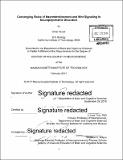| dc.contributor.advisor | Li-Huei Tsai. | en_US |
| dc.contributor.author | Durak, Omer | en_US |
| dc.contributor.other | Massachusetts Institute of Technology. Department of Brain and Cognitive Sciences. | en_US |
| dc.date.accessioned | 2017-05-11T19:53:32Z | |
| dc.date.available | 2017-05-11T19:53:32Z | |
| dc.date.copyright | 2017 | en_US |
| dc.date.issued | 2017 | en_US |
| dc.identifier.uri | http://hdl.handle.net/1721.1/108880 | |
| dc.description | Thesis: Ph. D., Massachusetts Institute of Technology, Department of Brain and Cognitive Sciences, 2017. | en_US |
| dc.description | Cataloged from PDF version of thesis. | en_US |
| dc.description | Includes bibliographical references (pages 158-173). | en_US |
| dc.description.abstract | Neuropsychiatric Disorders are the leading category contributing to disability-adjusted life years (DALYs) in the U.S. according to the World Health Organization. These findings underline the vast burden caused by neuropsychiatric disorders on patients. However, effective treatments do not exist for many of the neuropsychiatric disorders mostly due to lack of understanding of disease pathology. Evidence from whole genome sequencing of psychiatric disorder patients increasingly suggest that Wnt signaling and cortical development - in addition to other perturbations - may underlie the pathophysiology of multiple disorders. Furthermore, besides autism spectrum disorder, contribution of neurodevelopmental dysregulations to disease etiology in late-onset disorder such as schizophrenia are becoming widely accepted. Therefore, a better understanding of cortical development and functions of Wnt signaling could prove critical in determining the cellular and molecular mechanisms underlying the causes of psychiatric disorders. The work presented in this thesis aims to understand the functions of multiple neuropsychiatric disorder risk genes in brain development, and the converging role of Wnt signaling in neurodevelopment. First, we determined ASD risk gene Chd8 to be a positive regulator neural progenitor proliferation in the developing mouse brain through its transcriptional regulation of cell cycle and Wnt signaling genes. Surprisingly, Chd8 exhibits a cell type-specific modulation of Wnt signaling. Furthermore, knockdown of Chd8 in the upper cortical layer neurons caused ASD-related behavioral abnormalities in adult mice, which could be rescued via induction of Wnt signaling. Secondly, we made the novel observation that bipolar disorder risk gene Ank3 (ankyrin-G) plays a crucial role in cortical neurogenesis through regulation of subcellular localization of [beta]-catenin, which is an essential component of Wnt signaling. Finally, the effects of brain-specific deletion of BcI9 on brain development and behavior were characterized using a heterozygous BcI9 deletion transgenic mouse line. Behavioral and brain development defects associated with BcI9 were shown to mimic some of the clinical symptoms observed in patients. Collectively, our results demonstrate a central role for Wnt signaling and cortical development in pathophysiology of neurodevelopmental and neuropsychiatric disorders. | en_US |
| dc.description.statementofresponsibility | by Omer Durak. | en_US |
| dc.format.extent | 173 pages | en_US |
| dc.language.iso | eng | en_US |
| dc.publisher | Massachusetts Institute of Technology | en_US |
| dc.rights | MIT theses are protected by copyright. They may be viewed, downloaded, or printed from this source but further reproduction or distribution in any format is prohibited without written permission. | en_US |
| dc.rights.uri | http://dspace.mit.edu/handle/1721.1/7582 | en_US |
| dc.subject | Brain and Cognitive Sciences. | en_US |
| dc.title | Converging roles of neurodevelopment and Wnt signaling in neuropsychiatric disorders | en_US |
| dc.type | Thesis | en_US |
| dc.description.degree | Ph. D. | en_US |
| dc.contributor.department | Massachusetts Institute of Technology. Department of Brain and Cognitive Sciences | |
| dc.identifier.oclc | 986239777 | en_US |
